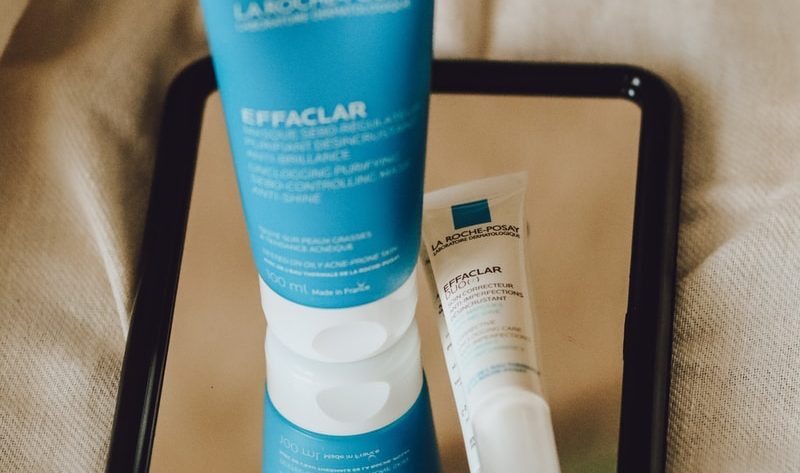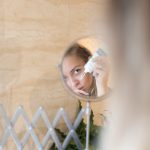Some of my vivid childhood memories are of having pink-toned skin. My school had many sports and I wondered why my skin was so different from other girls. But, my family has similar complexions, so I just brushed it off. My nights out were cut short when I had to go to the bathroom to wash my hot, red face. Late arrivals to lecture halls would cause a severe flush. Staying in for dinner with roommates and ordering takeout would leave me with a swelling face that was dotted with pustules.
I was confused. I’d never had “bad” skin. In fact, I hadn’t even thought about a skin-care regimen. The excessive redness I felt must have been an allergic reaction or an infection, and was therefore easily treated. So you can imagine my surprise when my school’s doctor explained, “It’s rosacea and there isn’t a cure.”
According to London-based consultant dermatologist Dr. Justine Kluk, rosacea can be a long-term skin condition that causes facial redness and flushing. She explains that rosacea is most common in the 30s and more common in people with fair skin. What causes it? Dr. Kluk states that there are many factors that can contribute to the development rosacea. These include genetics and blood-vessel abnormalities as well as hormonal influences, microorganisms and diet. It is more than a red face.
Broadly speaking, Dr. Kluk identifies four different types of rosacea, which may overlap: erythemato-telangiectactic rosacea (redness, flushing and dilated blood vessels), papulopustular rosacea (acne-like breakouts), phymatous rosacea (skin swelling and thickening, e.g. Ocular rosacea (swollen eyes and gritty eyes) is the most common type. She says that it often starts with an increased tendency to blush or flush more easily. “Over time, sufferers can develop permanent reddening of the nose or cheeks as well as a variety of unpleasant symptoms such as pimples and skin dryness, scaling and pilling of the skin, burning and stinging, and sensitivity to multiple skin-care products.”
Over time I met dermatologists and doctors who were compassionate, understanding, and knowledgeable about my rosacea. Unfortunately, my first journey was not easy. After my first appointment, I felt devastated. I was left without any information and with a medicated gel. It made me feel like I had wasted the doctor’s time.
Today, it’s not uncommon to come across a blogger, makeup artist, or dermatologist posting tips on how to care for multiple skin conditions, including rosacea. Back in 2000, we had limited access to magazines and family members, so a lot of advice was subjective. I didn’t know anyone else with a skin condition, and I couldn’t tell anyone how I really felt about my skin. I did lots of research online, and found forums where people with similar rosacea problems as me shared their successes and failures. This led me to the never-ending quest for my triggers.
Dr. Kluk identifies the potential causes as exposure to sunlight, strong winds and stress. In order to manage my rosacea over the past 14 years, I have made changes to almost every part of my life. My diet has been changed (less alcohol, very little dairy, less sugar), as well as my lifestyle (no hot baths, no heat styling, and avoidance of extreme temperatures). I’ve also learned to manage my mental health, such as work and social stress and dealing with self-esteem issues, and I started a rosacea-focused blog because I wanted to provide the information and support that I didn’t receive 14 years ago.
The skin care is the final step. Simple and consistent are two of my skin’s favorite things. My skin is prone to seborrheic and rosacea so I am very particular about the products I use. Since childhood, I am a huge fan of French-pharmacy beauty products. Brands like Bioderma, Avene and La Roche-Posay have all been part of my routine. My specific regimen might not be suitable for everyone, but it works for me.
What is the best skin care routine for rosacea?
In the evening, my skin is cleansed with La Roche-Posay Toleriane Derma-Cleanser. This removes all makeup and doesn’t leave it feeling tight or hot. After cleansing, I apply a hyaluronic-acid serum such as La Roche-Posay Hydra B5 and a simple moisturizer such as La Roche-Posay Toleriane Moisturizer. At 35, I’m beginning to spot the first signs of aging, so I also include a low-level retinol twice a week – I always rave about La Roche-Posay Redermic [R] Anti-Aging Retinol Treatment.
The skin can be transformed by vitamin A derivatives like retinal. However, as with all ingredients in rosacea, you need to do a lot more research and be cautious about using them. You may experience skin sensitivity such as flaking and purging. It might be worth visiting a dermatologist if you are having trouble getting your skin care routine just right.
What is the best night skin care routine for rosacea?
I use the same cleanser and serum for my morning and evening routine. Then, in the morning I apply the sunscreen SPF must be able to work under makeup, and it shouldn’t feel heavy on my skin. My all-time favorite is La Roche-Posay Anthelios Ultra Light Fluid 50+, but I’m also a fan of SkinCeuticals Sheer Mineral UV Defense for protection with added natural-looking, light coverage.
For those times when my rosacea flares, I have a few quick-fix items in my arsenal. These products help cool and soothe my skin. The travel-sized Bioderma Hydrabio Brume works well to soothe the prickly itching and lives in my handbag. I keep a pot of SkinCeuticals Phyto Corrective Masque in the fridge and whack that on if my skin is feeling warm and tight. La Roche-Posay’s Cicaplast Baume (B5) is my ultimate savior. It repairs the skin’s barrier, reduces tightness, moisturizes and can even be used on burns and rashes.
This routine was developed over time through trial and error. Dr. Kluk suggests oral medications that are used to treat anxiety and menopausal symptoms, such as beta blockers or Clonidine, if flushing is the most troubling symptom. Creams and gels that contain antibiotics or azelaic acids may reduce redness or pimples. Dr. Kluk states that Ivermectin cream, a recent addition to the range, is also a topical agent for rosacea. Brimonidine gel is another option, which reduces redness and causes constriction in dilated blood vessels. Visible vessels can be targeted with vascular lasers if these methods do not provide enough relief.
Rosacea does not have a cure. If I had to learn anything it was that it takes a lot of care. It can be managed, however. I hope that both my writing and social-media channels offer helpful advice on lifestyle, makeup, and skin care, but more importantly I hope that I can demonstrate that living with a skin condition doesn’t have to mean hiding or being ashamed of your face. Our unique skin isn’t the most interesting or important thing about us. It should be accepted. That is why I refuse to let my skin dictate or control me.






